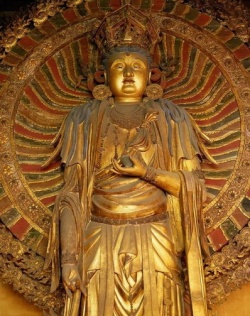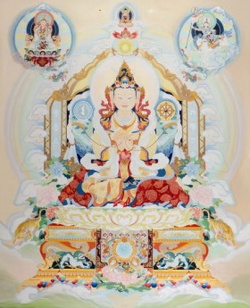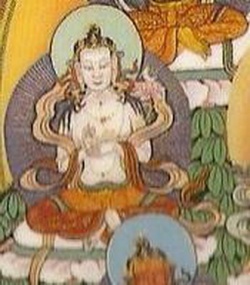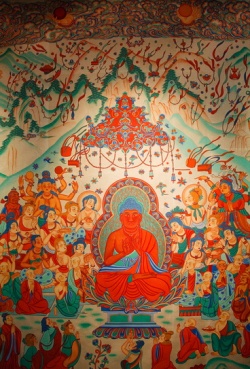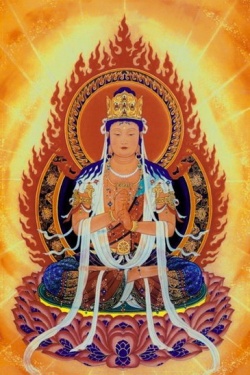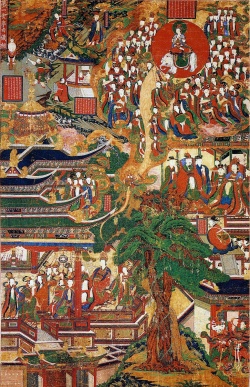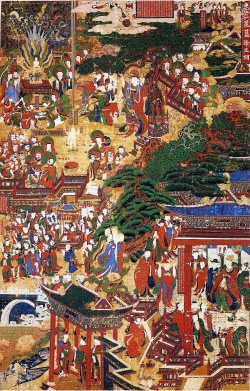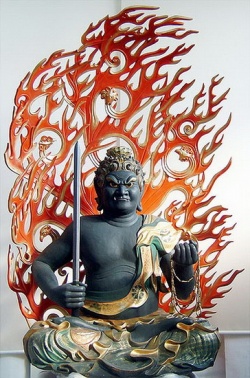Some aspects of Jataka paintings in Indian and Chinese (Central Asian) art
An important linkage between the Ancient Art of India and China is provided by Buddhist narrative episodes especially the Jataka tales detailing the previous lives of Buddha. Each story ends with a moral illustrating the Buddhist ideal of Dharma and self-sacrifice in diverse forms. The tradition avers that these stories were narrated by Buddha himself during the course of his sermons to drive home the message that by constant practice of virtuous deeds or Paramita (the highest virtue) one reaches the status of the “Enlightened One”. In these tales, the pre-Enlightened Buddha was designated as the “Bodhisattva” -- a lay creature on the path of Enlightenment, in the Form of a humam being, animal, birds, fish etc.
Paramita consists of a host of spiritual values such as Dana (liberality), sila (moral precepts), Kshanti (forebearance), Virya (energy), Prajna (Knowledge), and satya (truthfulness). Through vivid story-depiction the Bodhisattva through the Jataka tales sought to inculcate virtuous living amongst his followers rather than insistence on doctrinal dogmas triyng to create a new Faith that the level of the commoner . The Jataka stories demonstrate the exemplary behaviour on the part of one whose highest example was the accomplishment of highest Knowledge .
Thus Bodhisattva as depicted in the Jatakas was an aspirant after Knowledge who wanted to rise through a chain of good deeds and virtuous living to the exalted status of Buddhahood. The original concept of the Jatakas support the belief in Rebirth and the principle of Karma. Despite their Buddhist affiliation, the genesis of the Jataka stories is shrouded in obscurity. No Doubt, they were reduced to Writing (in Pali) of a much later after the passing away of Buddha, but they seem to have been a part of India’s archaic oral tradition which was presented in a Buddhist context with necessary modifications in the early historical periods. The evidence preserved in early Buddhist Art of Bharhut and Amaravati reliefs and other sites shows that by about the second century B.C., their narrative forms were more or less standardized. The Jataka stories in Bharhut reliefs bear inscribed captions probably with a view to educate those Buddhist worshippers who were visiting the sacred sites, urging them to follow the righteous path. The Jatakas are numerous, nearly 500 or so referring to significant events relating to the lives of the Bodhisattvas constructively preparing for a higher goal leading to perfection of Knowledge.
The Jatakas unfold, with great artistry and convincing Power the entire panorama of ancient Indian Life, laden with scenarios of passion and Compassion, wickedness and benevolence, reward and punishment, Life and Death. There is also a fluent sculpturing of the Jataka tales for the sheer delight of story-telling which has indeed emigrated from India far beyond her boundaries to enliven and enrich the Art and culture of the country that adopated it. The Jataka stories became a favourite subject with artists in ancient India, Ceylon, [[Wikipedia:Central Asia|Central Asia]], China, Nepal and Tibet. These stories exercised a great moral influence on the people, establishing a firm conviction that merit would result from performing virtuous acts of courage, liberality, fortitude, nobleness and self sacrifice.
The Pali Jatakas are the 10th book of the Khuddaka Nikaya. They had attained popularity among the students of religion and culture on accout of their noble contents, apart from furnishing valuable Information on the social, political and religious Life of the people in ancient India. It is interesting to note that each story opens with a preface which describes the circumstances in the Life of The Buddha which led him to tell the story of his past lives. The Jataka stories depict the long series of encounters in Life faced by the Enlightened One in his previous lives when he existed as a Bodhisattva. At the end of every story there is a brief summary in which The Buddha identifies the different persons in the story.
The Jataka narratives perhaps rose from the oral literature of Madhyadesa (the “middle country”) coinciding with the areas of Harayana, Uttar Pradesh and Bihar. Some of the tales are also found in a modified version in the Pancatantra, Kathasaritsagara, etc. while in some other cases they have parallels in the Mahabharata, Ramayana, Puranas and a few episodes mentioned in the religious literature of Jainism. The Northern Indian flavour of the Jataka tales is evident. Many Jatakas occur in the Mahavastu in prose as well as in verse written in mixed Sanskrit. A careful study of the Jatakas shows that the stories are highly edifying and have various purposes to serve. However, the proto-Mahayana schools like Sarvastivadin Buddhists also added certain sacred episodes based on earlier traditions called “Avadanas” which are also represented in arts. Yet, the Jatakas never lost their significance. According to Saddharmapundarika Sutra, Buddha himself admitted that he had been utilizing sutras, gathas and Jatakas to highlight his teachings. (II. 45)
Aryasura’s Jatakamala (meaning “the garlands of birth stories”) written originally in execellent Sanskrit is a very important text for the study of Jatakas, which were adopted from the Pali versions belonging to the canonic literature of the Theravada school. The Jatakamala was affiliated to the Northern (Mahayanic) Buddhism. Perhaps there was more than one Jatakamala. Somendra, the son of the reputed medieval Kashmiri writer Ksmendra (author of the Avadana Kalpalata ) observes: “There exist many Garlands of Birth Stories of the Jina by Gopadatta and other teachers, who, discarding the usual order of the Avadanas, gathered tales and told them at length in elaborate prose (gadya), interespersed with verse, holding themselves free as to the proportion of the two styles, which they made interchange. They all treat of the praise of the right path, but owing to their profoundness, are hard to understand.”
The Jatakamala , written in the purest Sanskrit in good lengths, is a selection of 34 Jatakas with the avowed object of arousing the true Faith in the minds of the readers. Aryasura, its author, was a gifted writer. His 34 episodes were selected from such birth stories which had had a long circulation before his times in India. Suraya says that the tales penned by him were faithfully adopted in Writing from the oral traditions, but there were also omissions of certain insignificant details so that the elegance of style and the Concentration of thought content were achieved. For instance, Jujuka, the Brahmana in the Visvantara Jataka, is simply referred to as a Brahmana here. About the author of Jatakamala , i.e. Aryasura, no firm identity has been established so far. Taranath identifies him with Asvaghosha. In all likelihood, Aryasura must have lived before 460 AD, as we find the painted verses from Jatakamala in Ajanta depicting Kshantivada Jataka in Cave II which itself has been dated to the latter half of the 5th century A.D.
Jataka stories adorn many ancient Indian monuments including Bharhut and Sanchi during second and first century BC, in Amaravati and Goli during 2nd and 3rd century A.D., and also in the Caves of Ajanta from 2nd century B.C. to fifth century AD and elsewhere during the later periods. The Chinese pilgrim, Faxian, while visiting Ceylon around AD 412 saw at Abhayagiri depictions of the 500 various presentations of the Bodhisattva during his various births. Xuanzang, another Chinese pilgrim of the 7th century, mentioned stupas erected in honour of the Bodhisattva whose deeds were related in the Jatakas. We now take up four Jataka stories and discuss their places in Indian and Chinese Art. Painted parallels of Ajanta Jataka scenes are available in the Chinese Central Asian Art especially at Dunhuang, Kizil, Miran, etc. bringing out various adapations of original Indian Jataka stories in localized versions.
In the murals of Ajanta presently, nearly twentyfive Jataka stories have been found painted in addition to two avadanas . A few Jatakas like Sama, Sibi, Hamsa and Saddanta Jatakas have been painted in more than two Caves. To some extent the painter had followed Aryasura in regard to Jatakas like Visvantara, Sibi, Matsya, Hamsa, Ruru, Kapi, Ksanti, etc. but with modifications whenever required. The Sibi Jataka in cave No.1 follows the archaic Brahmanical (Mahabharata) version while its depiction in cave No.17 remains faithful to Jatakamala with certain additions of details to highlight the story. The portrayal of Shyama (Sarvan) and Saddanta Jatakas in cave No.10 (dated 2nd/1st century B.C.) follows the Pali version, so also are the paintings of most of other Jataka stories in later Caves of the 5th century A.D. Yet it is evident that the artists who created these Jataka painting had also drawn inspiration from other available sources of Information as well as their own imagination.
It is worth mentioning that in eastern [[Wikipedia:Central Asia|Central Asia]] the artists worked at Kizil seem to have drawn inspiration from the Art of Ajanta especially in the case of the representation of the Jatakas and Avadanas. Scholars have invited our attention to the fact that many of the Jatakas and Avadanas depicted in Kizil correspond to those painted in Ajanta, like Mahisha Jataka, Visvantara Jataka, the Sibi Jataka, the Maitribala Jataka, the Ruru Jataka, the Vanara or Kapi Jataka, the Hasti Jataka, the Purna Avadana, and Shyama, etc. There is however, some difference in the mode of delineation of the Jatakas, in Ajanta and Kizil. While at Ajanta mostly the stories are depicted in various scenes in spatial arrangement according to the different settings of the Jatakas, in Kizil only the most dramatic part of the story is generally delineated. There are however some exceptions in illustrating only the central idea of a Jataka.
Syama or Samaka Jataka: Amongst the older Jatakas at Ajanta which has parallels outsides is the Shyama or Samaka Jataka in the cave No. 10, a caitya hall narrating the story of Bodhisattva as Shyama who tirelessly served his blind hermit parents. The Jataka highlighted the role of an ideal son dedicated to the service of his aged father and mother setting an inspiring example for the common people. The details are as follows.
In one of his previous births, the future Buddha was born as Syama who was a model of filial piety. His old and blind parents lived as hermits in a remote part of the Himalayas. Syama was their sole support. One day when Syama went to a pool to fetch water for his parents he was struck by an arrow of the king of Benares who came there Hunting deer in the forest.
Indra was deeply impressed by Syama’s filial piety and restored him to Life. In China this story is known as Samaka Jataka which mentions that the king of Kapilavastu (instead of Varanasi according to the Indian tradition) went to the forest. While Hunting, he killed near a stream a hermit boy. When the king came to know that he killed the boy. He went to the boy’s parents and told them about what had happened and led them to where Samaka was lying. Samaka’s agony moved the Heaven and earth. Out of campassion a God placed an elexir into Samaka’s mouth and the poisonous arrow dropped from his Body; not only the boy was resurrected, but the eye-sight of the blind parents was also restored. A few scenes of this Jataka are also found in Cave No.17 at Ajanta. In Cave No.10 (Ajanta) four incidents of Jataka tale are extant: (i) the King with his retinue shooting an arrow towards Sama; (ii) The king grievously repentent on his accidental mistake; (iii) Sama’s blind parents wailing upon the wounded Body of Theri son in the hermitage; (iv) Sama’s resurrection to Life.
In Cave No.17 a surviving painting shows Sama carrying his blind parents, and the king carrying the Body of Sama, and then Sama preaching to the king (after he was resurrected to Life) like a true Bodhisattva.
The story of Syama has also a Brahmanical version in which the hero is Sravana Kumar instead of Syama. The dedicated son, Sravana was accidentally killed by King Dasaratha of Ayodhya on a royal hunt. Unlike the Buddhist version, the boy was not resurrected to Life. The blind parents wept loudly and cursed the king.
Xuan Zang who was in India (629-645 AD ) mentions in his description of Gandhara a Stupa about ten miles from Pushkaravati (Charsada) which was then believed to mark the site of the Syama Jataka, the story has been represented in the Art of Sanchi, Gandhara and Ajanta. The Indian (Syama) had a wide appeal because of the fact that it depicts Syama’s Love and adoration for his blind parents, an ideal which is of great social Interest. The representation of the story in Sanchi is a beautiful composition depicting the forest scenery. In Gandhara several episodes were grouped in a single frame. The boy with a pitcher on the shoulder indicates that he is going to collect water for his old parents. The figure of the king in his Hunting dress is represented twice. On the banks of the pool are shown cattle and deer and beyond them to the right the blind hermit and his wife are seated awaitng the return of their son who has gone to bring water for them. This representation is a mixture of forest scenery and human pathos.
The Chinese have translated “Sama” into “Shamo”, and “Samaka” into “Shang Mo Jia”. But the more popular name for “Samaka” or “Syama” is “Shanzi”, its first syllable being the transliteration of “Syama”, while its second syallable “zi” being no different from the suffix used for Confucius, Mencius, Laozi and other ancient thinkers. This fact shows that in China’s oral (and also written) literature, Syama has reached a stature of saints. Also, the story of Sama has been elevated to the status of Sutra -- there is the popularity of the text entitled Shanzi Jing (literally, the Sutra of Sage Sama).That Chinese tradition gives greater eminence to Syama Jataka than to other Jatakas tale was because of the importance of filial piety which was a corner-stone of the cardinal norms of the Chinese society. The story of “Chanzi” was a household word in China, having crossed the boundaries of Buddhism. It has become a part of China’s own spiritual tradition.
The depiction of Syama Jataka has appeared in the Dunhuang Caves and the Xinjiang grottoes. In Cave No.299 of Mogao there in a long horizontal panel decorating on the gorgeous ceiling: (1) the palace of the king, (2) the king’s hunt, (3) the king chasing a deer along a stream, (4) the king killing Syama by mistake, (5) Syama being buried, (6) Syama’s blind parents being informed about the tragedy, and (7) the resurrection of Syama. In comparison. the Xinjiang cave painting is much simpler, showing only the killing of Syama.
This and other portrayals of Syama Jataka at Mogao Caves, Dunhuang are elaborate and vivid. The final scene which shows the blind parents embracing their son’s Body and wailing in anguish represents poignantly the Grief of parting. The tragic tale ends on a happy note with the solution of Buddha’s magical Power resurrecting Samaka. The painting composition is tightly structured with a clear focus on the theme. People’s activities are interwoven with the landscape — hills, trees and the streams — making it a realistic representation. It has been inferred by scholars in China that the story was intended to convey the idea of loyalty and piety to the authority. At Ajanta (Cave No.17) there is a painting of another story of an elephant devoted to his blind parents, almost on the same theme, narrated through Matriposaka Jataka.
Visvantara Jataka: The most famous Jataka common to Buddhist Art of India and China is Visvantara or Vessantara Jataka (in Pali) from early times. The tale emphasises the importance of Dana or making Charity and gifts. According to the story in the kingdom of Sivi, there was a king named Sanjaya and he had a son Visvantara whose Generosity became a household word in the country and everyone rushed to him to solicit something. Visvantara tried his utmost not to disappoint anyone. One day he even gave away the auspicious white elephant, the harbinger of rain which was a national treasure, to a neighbouring kingdom which had suffered the visitation of draught. People in his own kingdom were indignant at his excessive Generosity and demanded his banishment. On the order of his royal father Visvantara left for the forest with his wife and two children. During the course of the journey he first gave away his horse, then the chariot. He even parted with his two children to a Brahmin (Indra in the guise of an old Brahmin demanded them from him). As if this was not enough, he even gave away his wife. The king of gods, Sakra (i.e. Indra) finally reunited him with his children, wife and father, and he returned to his kingdom welcomed by everyone.
Visvantara represents the last existence of Gautama Buddha as Bodhisattva. As a result of his meritorious deeds during the previous births Gautama attained Enlightenment and became Buddha. The Bodhisattva embarks on his journey from supreme sacrifice to supreme Knowledge as Buddha. He accepts all hardships of his banishment with Joy. While Visvantara is in the jungle no beast or bird of the forest does any harm to each other, and there is perfect Harmony and Friendship among all species till Visvantara bids goodbye to the forest to come back to his kingdom.
Visvantara personifies the highest virtue of sacrifice, the spirit of renunciation and Equanimity to fulfil Dana paramita. His story became the favourite piece for story-tellers, and was the poets’ ready reference and the artists’ delight. With the help of poets and artists Dana paramita became a universal tradition of ancient India.
The Visvantara narrative is found sculpted in the Art of Bharhut, Sanchi, Gandhara, Ajanta, Amaravati, Nagarjunakonda, Goli and Ajanta in India, and in Miran and Kizil in Chinese Turkistan and Dunhuang and many other places in China. In Sanchi, the depiction is to be found on the lower lintel of the northern gateway of the great Stupa. The episodes runs from right to left on the central portion of the outer gateway of the lintel, beginning at the right end. If we go throgh the Visvantara relief at Goli we are confronted with a completely sequential frieze, of which only the left end has been lost. The story is here presented in sequence from left to right. In the first scene that has survived, Visvantara, accompanied by a large retinue is riding at the city gate on the state elephant. The favourite presentations of Visvantara Jataka mainly highlight two places, viz, the forest and the palace. Narratives of the happenings in the palace and the city are arranged in the upper register and the forest scenes are in the lower register of the corridor wall of cave No. 17 of Ajanta. This combination has resulted in a powerful impact on the spectators, touching the inner chord of the hearts of the people.
The Visvantara Jataka seems to have been very popular in [[Wikipedia:Central Asia|Central Asia]] as in India. A. von Le coq discovered a very elaborate depiction of this Jataka at Kizil. The Greed of the black Brahmin beggar and the trepidation of the sons before they were gifted away by the compassionate Bodhisattava are vividly, poignantly and dramatically presented in a 7th century painting in one of the Caves. The representation of Jataka in Miran is also elaborate. The manner of delineation of the Jataka in Miran shows beyond Doubt the extension of Gandharan style to the eastern part of Xinjiang. Further it is intersting to note that there is a short Brahmi inscription on the thigh of Visvantara’s elephant which has been interpreted as being equivalent to Roman Tita. It shows that there were itinerant Roman artists who had moved to [[Wikipedia:Central Asia|Central Asia]] to execute Buddhist temple Art. The Amaravati sculpture as in the Miran paintaing very vividly shows the agitation of the people for the banishment of Visvantara. In both the places the king is seated on a throne with his right foot placed on a footstool and the hand is placed on the thigh.
On the left of the illustration at Miran is shown the gift of the elephant by Visvantara and on the right his gifiting away the cart and the bulls. But one significant thing to note is that the Amaravati panel omits to show Visvantara taking leave of his father -- the scene which is the vital link in the Central Asian painting.
In the Ajanta painting we find Visvantara taking leave first of his mother, Phusati and then his father king Sanjaya. The queen mother is shown seated on a throne, and Visvantara, kneels down before her with his hands joined in adoration. There are three maids depicted in three different poses below the queen and the prince. By the side of the queen there are a female chauri bearer and two more maids, holding ornaments probably for the prince to enable him to offer gifts according to his Heart’s desire. Visvantara is shown again near the feet of his father seated on the throne. The face of the king betrays anxiety. Here also Visvantara kneels down with folded hands. In both the places he is shown bedecked in jewellery and crown. The artist brings out very successfully the nobility of Visvantara’s character, i.e. his respect for his parents and obedience to his father’s wishes on the one hand and the anxiety of his parents and an overspread gloom in the palace because of impending banishment of Visvantara on the other.
When one compares the details of the Ajanta painting with those of the Central Asian fragment one hardly fails to recognise the identity of their subject matter. It is interesting to note that though the other parts of the story are found depicted in many sculptures and paintings, this particular incident of Visvantara’s taking leave of this father before going on exile survives now only in Ajanta but also in the Central Asian fragments.
The Visvantara Jataka occupies a pride of place in the Dunhuang Jataka paintings, albeit it is there assuming the identity of “Sadana Jataka” (named after the great river). The popularity of Sadana Jataka began probably with the founding of the Sui Dynasty by an emperor who was one of the most devout Buddhist rulers in Chinese history. Particular attention should be given to the painting of the “Sudana story” in cave No. 419 of the Mogao Grottoes, Dunhuang . When the Director of the Dunhuang Academy Prof. Duan Wenjie, visited us in 1991, he brought the Life size copy of this painting executed by none other than himself, which was 111.5cm in height and 359.5 cm in length. The original was painted during the Sui Dynasty at the turn of the 6th-7th century. The painting was almost a copy of the Ajanta “Visvantara Jataka” filled with the details about his gifting away the white elephant, his exile journey, his giving away the horse (hence he had to pull the chariot by hand like pulling a ricksha), then parting with the chariot, then the children, then the wife. The painting also showed God Sakra reinstating him to his Kingdom and his being welcomed back by the king and his people.
In comparison, while the Sudana story painted in cave No. 419 at Dunhuang did not highlight the restoration of the two sons to the prince, the Ajanta cave No.17 painting of Visvantara Jataka illustrated in the central portion the payment of a large sum of coins by king Sanjaya to the Brahman Jujaka for the return of the two grandsons.
Ruru(Deer) Jataka : The Ruru Jataka narrates the story of Bodhisattva’s birth as a deer, often regarded as sacred and innocent in India, particulary in the Buddhist tradition. There are other Jatakas mentioning the Bodhisattva’s birth as deer or stag two of which are also illustrated at Ajanta (Cave No. 17) - the Nyagrodha-Mriga and Sarabha-Mriga Jataka. In the Ruru Jataka story which has been portrayed in various sites in India and outside we see a deer being betrayed by an ungrateful man who should feel indebted to the deer for saving his Life from drowning. Instead, the man reveals the deer’s secret hideout to the king, which leads to the deer’s being captured. The turning point comes when the deer appeals to the conscience of the king by exposing the treachery of the man. The king finally corrects the wrong doing and gets the deer freed. It is a very interesting and moving story. The artists have depicted the various consecutive events of the story with great feeling.
Incidentally, in China we have the very popular story of the nine-coloured deer. The Mogao Grottoes in its Cave No. 257, have preserved a wall painting of the vintage of Northern Wei (439-534AD) which is 60 x 595 cm. in size. The reproduction of the painting was also exhibited in New Delhi at the IGNCA ground in 1991 along with other reproductions. The painting gives a detailed account of how the nine-coloured deer first saves a man from drowning. Then, the man discovers this marvellous animal and reports it to the queen who is a greedy person eager to capture the wonderful deer. The sequence of the painting goes on to show the capture of the deer because of the man’s leading the queen’s hunters to his secret hideout. In the centre of the painting is the conversation of the deer with the king revealing the treacherous deed of the man, as well as the sequential end of the deer’s being freed, and the man’s being punished.
Thus, we see that this story about the nine-coloured deer is a slight variation of the Ruru Jataka. In its Indian version, the deer (actually the deer-king) is a golden deer — while its Chinese counterpart is a deer of nine-colours. We know that the Chinese use numbers to describe things often in a figurative manner. They generally use the word “five-colours” to mean multi-colour, and there is no “six-colour” in Chinese vocabulary. Here, the usage of “nine-colour” is purported to indicate rarity. In this Chinese story, the deer is just such a rare treasure that one hardly comes across in daily Life. This conforms to the theme of the Ruru Jataka. Why has the Chinese version preferred to depict it as the “nine-coloured” rather than the “golden” deer is not clear to us. But, we know that to the Indians gold is the highest value of treasure. In real Life also there is greater treasuring of gold in India than in China which is a country that does not produce much gold. Another departure of the Chinese version is that instead of the king’s desiring to possess the deer (as is in the Indian version), it is the queen who is greedy (in the Chinese version). But, both the versions end with the king’s listening to the appeal of the victimized deer and performing justice. We know that according to the Chinese political tradition the king cannot be devious and is always the arbitor of justice. If the Chinese had to adopt the Ruru Jataka in its totality it would have compromised the image of such an arbitor. So, the changed detail (putting the blame on the queen, but never the king) is out of political considerations. There is another deviation in the Chinese story’s ending with the treacherous man’s being punished which is not mentioned in the Indian Ruru Jataka. We must add that the reproduction we saw in the IGNCA exhibition in 1991 was executed by no other person than Prof. Chang Shuhong, the legendary Founder-Director of the Dunhuang Research Institute (now the Dunhuang Academy) who had passed away about five years ago. It was a marvellous painting which cannot be surpassed in skill, colour scheme and characterization. This painting joins its original inside the Dunhuang cave to rank as real masterpieces that human efforts can create. They are not only the finest depictions of the Jatakas one has ever seen, but can be considered as among the greatest paintings of China — even of the World.
Sibi Jataka: The kingdom of Sibi produced many virtuous kings of whom was the son and successor of King Ushinara. This new Sibi king was known for his philanthrophy among his other virtues. One day, Indra and Agni came to test this. The two deities disguised themselves as a hawk and a pigeon. The hawk started chasing the pigeon who fell on King Sibi’s lap trembling with fear. The hawk demanded the king to surrender the pigeon as its prey. This the king refused, as he decided to protect the poor thing who had taken Refuge under his protection. After much argument the hawk agreed to leave the pigeon alone if the king would offer a piece of flesh from his own Body which was equivalent to the weight of the pigeon. The king was more than happy to make such a sacrifice. Strangely, after endlessly cutting off his own flesh from different parts of his Body and putting it on the scale, the king found that the pigeon still overweighed. Then the king threw his entire Body to the scale even then he could not equalise the weight of the bird. At this point the hawk and the pigeon revealed their true identity and offered boons to the king for his unbounded charitable spirit. There are many versions of the Sibi Jataka and the one narrated above is found in the Mahabharata also. In the Jatakamala the story of Sibi is somewhat different. Indra came as a blind person to king Sibi and asked him to donate one of his eyes so that he could regain his sight partially. Sibi, however,offered both eyes for the complete restoration of the blind man’s sight. The ready willingness of king Sibi to sacrifice both his eyes moved Indra into revealing his true Form and going away after giving boons to the king. A stone slab from Nagarjunakonda depicts a scene from Sibi Jataka wherein the story resemble king Sibi of the Mahabharata and the king is required to tear out flesh equal in weight for the pigeon. There is a man standing with a Balance in the hand while the king is engaged in cutting flesh out of his Body. In a panel from cave No. 17 at Ajanta, showing warriors with Weapons, flags and buntings, rejocing in the capital and eulogising the King’s virtuous deeds.
In the above we see that there are two versions of Sibi Jataka in Indian literature: one is King Sibi’s parting with his own eyes , and another his willingly having his flesh cut off in order to save the dove. The Chinese have bifurcated these two according to the narratives of the scriptures. The king who sacrifices his eyes is named “Kuaimu Wang” (the king with happy eyes) which is the Chinese translation of Sanskrit “Sudhira”. The Chinese name for “Sibi” is “Shibi” which transcribes the Sanskrit sound. A very interesting painting in Mogao Cave No.275, illustrated during the period of Northern Liang (421-439) is a panel of the size of 76.5x 312.5cm. The panel has five Jataka tales in a roll horizontally arranged. The picture on the extreme right is the story of King Sudhira’s donating his eyes to a blind Brahman. The next picture on its left depicts King Sudhira’s sacrificing his flesh. The copy of this panel was exhibited in IGNCA in 1991-92, and the artist who copied it, Prof. Shi Weixiang, was also a guest of IGNCA at the time.
There are a number of paintings pertaining to the story of King Sibi (sacrificing his flesh) inside the Dunhuang Caves. Two paintings came to the IGNCA exhibition. Apart from the Northern Liang painting mentioned just now, there is another in cave No. 254 in the Mogao Grottoes of the vintage of Northeren Wei of the size of 122.5 X 164 cm. Once again, this was copied by Prof. Duan Wenjie. The painting makes an excellent depiction of the king who occupies the central place. The pigeon stands on his lap in a pitiable shape. Surrounding this central scenario are the other details of the story. There is the hawk, and also the scale. The cutting of flesh and other details are also in the painting. The central figure of the painting, i.e. King, Sibi is ably presented as a kind-hearted Bodhisattva without any fear of self-sacrifice. The illustration has brought out the enlightened Bodhisattva spirit to the fore which is exactly what the Jatakas have aimed at.
The Jatakas have provided just one of the innumerable platforms for India and China to unite their minds and hearts. The examples shown above exemplify the echoes of the two great civilizations -- India and China. There is a vast field for scholars of both the countries to inquire into the India-China cultural interface and affinity. When more Indian scholars join in this endeavour there will be greater results of purposeful research. During our visit to China (myself accompanied by prof. Tan Chung ) in 1996, we discovered the keen expectation on the part of our Chinese brethren — to interact and exchange with their Indian counterparts. It is hoped that Indian scholars do not disappoint them. We must not think that by so doing we do them a favour. It is a good opportunity for us to learn as well. The more we understanding the Chinese cultural development, the more we know better about our own neighbours. The Art treasure like what is preserved in the Mogao grottoes is the cultural heritage of China, India, and the entire humanity. The rich Information and insight stored in this treasure must be further explored for the benefit of our understanding of India’s cultural past. Let us join with fellow archaeologists, Art historians and scholars of other disciplines in China to launch a joint venture for the good of human Knowledge and Wisdom as well as international amity, peace and Harmony. Just as the Jataka stories have been invented to promote all such ideas and ideals in our mundane World, so should we be inspired to carry it further so that more and more human beings are turned into the good examples of Bodhisattvas.
References
Banerjee, P, New Light on Central Asian Art and Iconography, Abha Prakashan, New Delhi, 1992.
Banejee, Radha, Ashtamahabodhisattva (The Eight great Bodhisattvas in Art and literature), Delhi, 1994.
Ghosh, A (ed), Ajanta Murals , New Delhi 1967.
Griffithe, J, The Paintings in the Buddhist Cave temple of Ajanta, London, 1896-97.
Kern, H (ed),The Jatakamala by Aryasura , Boston, 1883.
Marshall, J and Foucher, A, The Monuments of Sanchi, vol, II-III, Calcutta, 1940.
Mishra, Jagadish Chardra, Jatakamala(Bodhisattvavadanamalaparaparyaya) of Aryasura,
(with Hindi presentation), Varanasi, 1987.
Mitra, Debala , Ajanta, ( tenth edition), New Delhi, 1992.
Ning Qiang, “Cong Yindu dao Zhongguo -- mouxie bensheng gushi goutu xing chengde bijiao” (From India to China -- A Comparations of some Jataka story illustrations), in Dunhuang Yanjiu ( Dunhuang Studies), No. 28 (1991), pp. 3-12.
Zhao Xiurong, “Shilun Mogaoku 275 ku beibi gushihuade fojing yiju” ( A northern study on the Jataka story paintings on the northern wall of Cave No.275 of the Mogao Grottoes), ibid, pp.13-27.
Tan Chung , Dunhuang Art through the eyes of Duan Wenjie, IGNCA, New Delhi 1994.
Yazdani, G, Ajanta (text and plates), vol. I-IV, (Oxford, 1930-55)
